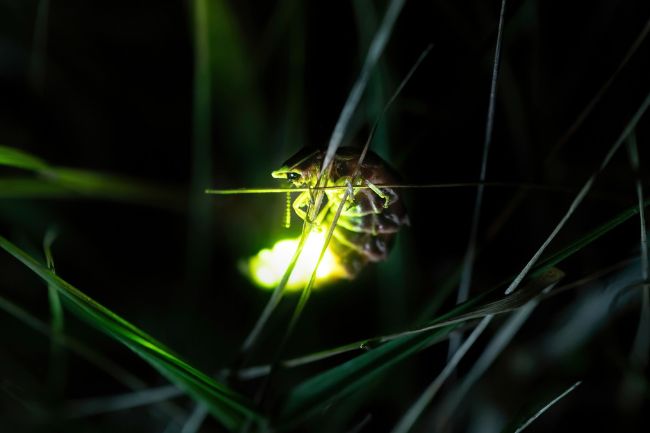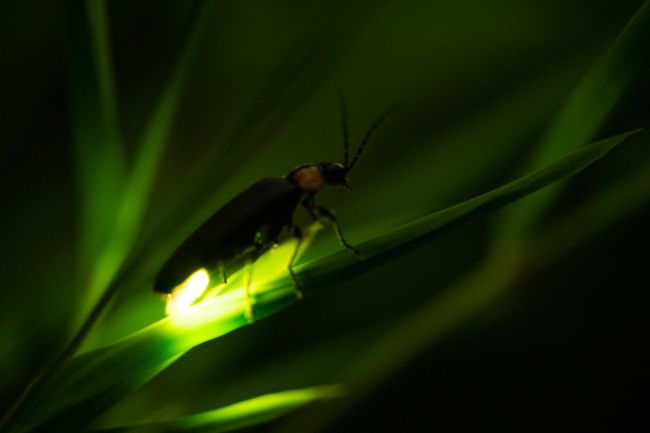There are over 2,000 species of firefly across the world, that can eat a variety of diets. Most species are carnivores as larvae and eat a mixture of nectar, pollen and small insects as adults. Some adults do not eat at all.
What do fireflies eat?

There are over 2,000 species of fireflies across the world. Fireflies are a type of beetle that produces a bioluminescent light, either as an attempt to ward off predators or to attract a mate. Within the UK, fireflies are called glowworms, whereas the glowworms of New Zealand are a type of gnat, not related to firefly species elsewhere.
| Food Source | Description |
|---|---|
| Nectar | Fireflies feed on the nectar of flowers |
| Pollen | Fireflies may consume pollen as a source of nutrients |
| Small Insects | Some firefly species prey on small insects like gnats, mosquitoes, and aphids |
| Soft-bodied Invertebrates | Firefly larvae often feed on soft-bodied invertebrates like snails and slugs |
These various species live in many different habitats and climates across the world. Depending on the species, they have slightly different dietary preferences, which can vary from their larvae form to adults.
Soft-bodied invertebrates
Many fireflies eat largely soft-bodied invertebrates, particularly when they are in their larval forms. Such invertebrates include slugs, snails and worms. These are easy prey for the relatively slow-moving firefly larvae.
Also read: Wondering “If an Earthworm is an Insect?” (Explained)
Other invertebrates
Many adults are also carnivorous, but they tend to focus on small invertebrate species, such as small beetles or flies. They are likely advantageous predators, simply feeding on what is easily available to them.
Nectar and pollen
It may surprise you to learn that fireflies are one of our many species of insect that are also pollinators. This is because as adults they visit flowers to both eat the pollen and drink the nectar they provide.
When they visit these flowers the fireflies get some pollen on themselves, which they then transfer to other flowers, causing cross-pollination.
Also read: Why are Bees Important to Plants? (Pollinators)
Cannibals
While standing amongst the fireflies in the middle of a clearing, might be somewhat romantic, it may seem less so if you knew that some of those little lights were trying to eat each other.
Photuris firefly females are well-known for using their light to deceive and trap the males of other firefly species. Sitting high in the vegetation, they mimic the light pattern of the species they wish to attract, making the males think they are a female of their species.
Once the males come close to mate, this sneaky female grabs and eat them. A somewhat gruesome reason for such beautiful lights.
Nothing
In some species of fireflies, the adults are not thought to eat at all. This isn’t uncommon in insects, with all the feeding being carried out as a juvenile and the adult stage is entirely for mating. These adults cannot live long without food and will die if they do not mate soon.
How do fireflies eat?

Like many insects, fireflies have a series of mouthparts, that help them to tear apart and eat food. This includes a pair of mandibles that help them to grasp their prey. As well as mandibles they have a set of maxillas, set behind the mandibles, that help them to further chew and break down their food.
| Feeding Behavior | Description |
|---|---|
| Adults | Adult fireflies primarily feed on nectar and pollen from flowers using their mouthparts |
| Larvae | Firefly larvae are predatory and feed on small insects, snails, and other soft-bodied invertebrates |
| Bioluminescent Hunting | Some firefly larvae attract and capture prey using their bioluminescent glow |
Once the food is swallowed, it enters the digestive system of the firefly. This includes a crop and stomach for further digestion. Once through the stomach, the food enters the intestines where the last of the nutrients are removed before it is expelled via the anus, in the form of faeces.
Like many insects, fireflies don’t pee, as they retain as much moisture as they can and expelled any waste matter in a solid form.
How often do they eat?
Like many species, how often fireflies eat isn’t known. Most appear to feed regularly, though the larvae can survive several days without eating. Adults of some species do not eat at all and can survive several days to weeks on reserves stored up from when they were larvae.
What do they drink?
Like many invertebrates, fireflies do not need to drink a great deal to survive. As their food provides them with plenty of water, they may only drink occasionally from dew and raindrops.
Adult fireflies may drink nectar as part of their diet, which has very high water content. This means they do not need to drink additional water. Some adults do not eat at all, as they do not live long enough, this possibly means they do not bother to drink either.
| Drinking Behavior | Description |
|---|---|
| Water Sources | Fireflies obtain water from various sources, including dew, raindrops, and moist vegetation |
| Water Conservation | Fireflies have adaptations to minimize water loss, such as specialized excretory structures and behaviors like reducing activity during dry periods |
Like many non-aquatic invertebrates, they cannot swim, meaning that large areas of water are a danger to them, and may cause drowning.
What do fireflies eat in captivity?
In captivity, fireflies can be fed a variety of foods depending on their species and the stage they are at. As many adults are thought to eat nectar, those that keep fireflies often offer them flowers to feed from or a sugar water substitute.
Larvae or carnivorous adults can be offered invertebrates to eat, such as worms or maggots.
What do firefly larvae eat?
Most firefly species spend the majority of their lives in their juvenile form, as larvae. These larvae are carnivorous, spending their time hunting through the grass for soft-bodied invertebrates.
Their favourite foods tend to be slugs, snails and worms, which they catch with their pincer-like mandibles.
While some firefly species live only a year, others will overwinter as larvae. During the winter, most larvae will enter diapause, a type of hibernation. During diapause, the larvae will live off fat reserves and rarely eat.
The hungry firefly
When it comes to fireflies, it seems the larvae are possibly the most ravenous stage of this bright and fascinating insect. Hunting through their miniature world, firefly larvae need to eat as much as they can as quickly as they can, so they can turn into strong adults and mate.
The adult diet is much less understood, perhaps because they are more difficult to observe and more varied in their diets. Still, as they flutter through the night, to light up the vegetation, it’s good to know that some of these bright and shining lights are responsible for some of the flowers that surround us, and equal the firefly’s glow in natural beauty.

